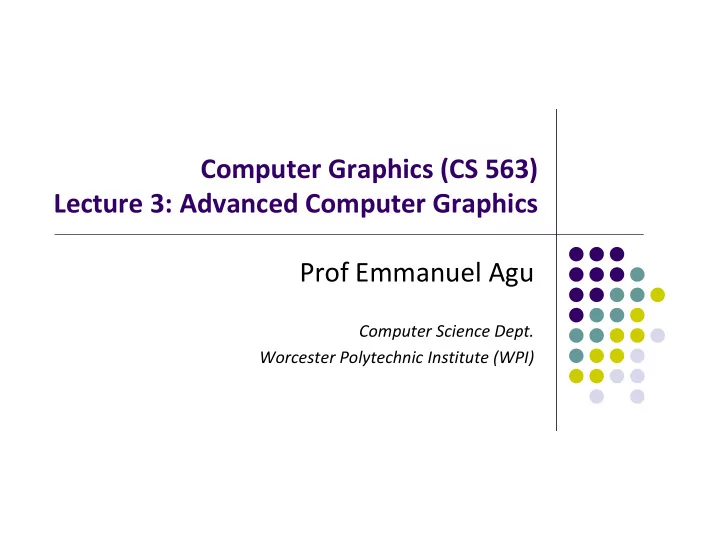

Computer Graphics (CS 563) Lecture 3: Advanced Computer Graphics Prof Emmanuel Agu Computer Science Dept. Worcester Polytechnic Institute (WPI)
Advanced Shading Radiometry: field concerned with transmission of light Photometry: concerned with how humans see transmission of light Visible spectrum: Wavelengths human eye can see Ranges from about 400 ‐ 750nm
Radiometric & Photometric Quantities Radiant Energy, Q (Joules): Radiant energy of photons in a light source Radiant Flux (Watt) or power, dQ/dt: Joules emitted per second Irradiance: dQ/dA: Joules per unit area
Irradiance Irradiance measures light flowing into a surface Exitance measures light flowing out of a surface Solid angle: set of angles in 3D, measured in steradians (sr)
Radiance
Unit Projected Area
Colorimetry Humans can distinguish about 10 million colors Human eye sees wavelengths between 380 ‐ 700nm Different surfaces reflect/suppress different wavelengths
Colorimetry Light going into eye detected by retina in the eye Retina has 3 types of receptors => Color represented typically by 3 numbers (CIE, RGB, etc) Representations can be converted. E.g. RGB to CIE
Light Sources Abstractions that are easier to model Point light Directional light Light intensity can be independent or dependent of the distance between object and the light source Spot light Area light
Textured Lights Use a texture to modulate light intensity Below: light modulated by leaf texture pattern
BRDF Theory BRDF: Bidirectional Reflectance Distribution Function Expresses energy reflected in outgoing direction given incoming direction Subsurface scattering (BSSRDF) Surface reflection (BRDF)
Visualizing BRDFs Visualize output in any direction for given incoming angle
Fresnel Reflectance Equation that determines what fraction of incident light is reflected (and what fraction is transmitted)
Fresnel Reflectance Depends on angle of incidence and material
Fresnel Reflectance Usually, physics table for each material’s fresnal reflectance at zero degrees of incidence
Microgeometry Basic idea: model surfaces as made up of small V ‐ shaped grooves or “microfacets” Average Incident normal m light Many grooves occur at each surface point Only perfectly facing grooves contribute Can describe distribution of (aggregate) groove directions E.g. half of grooves at hit point face 30 degrees, etc
Microgeometry Rougher surfaces bounce light all over the place Increasing roughness
Isotropic Vs Anisotropic Surfaces Isotropic: light bounced equally in all directions Anisotropic: Surface has grooves with directions. E.g. Brushed steel Light bounced differently along vs across the grain. Anisotropic (brushed steel) Isotropic
Self ‐ Shadowing Some grooves on extremely rough surface may block other surfaces
Self ‐ Shadowing: 2 Cases Masking: No blocking of incident light, partial blocking of exitting light Shadowing: Partial blocking of incident light, no blocking of exitting light
Microfacet BRDF Models Microfacet BRDF models such as Cook ‐ Torrance model assume V ‐ shaped grooves Typically expressed using groove distribution, microfacet and shadowing terms. Example: Cook ‐ Torrance specular term F DG , cos m v Where Note: ambient and diffuse terms D ‐ Distribution term same as Phong ambient and diffuse G – Geometric term F – Fresnel term
Other Microface BRDF Models Oren ‐ Nayar – Lambertian not specular Aishikhminn ‐ Shirley – Grooves not v ‐ shaped. Other Shapes Microfacet generator
BRDF Evolution BRDFs have evolved historically 1970’s: Empirical models Phong’s illumination model 1980s: Physically based models Microfacet models (e.g. Cook Torrance model) 1990’s Physically ‐ based appearance models of specific effects (materials, weathering, dust, etc) Early 2000’s Measurement & acquisition of static materials/lights (wood, translucence, etc) Late 2000’s Measurement & acquisition of time ‐ varying BRDFs (ripening, etc)
Measuring BRDFs Murray ‐ Coleman and Smith Gonioreflectometer. ( Copied and Modified from [Ward92] ).
Measured BRDF Samples Mitsubishi Electric Research Lab (MERL) http://www.merl.com/brdf/ Wojciech Matusik MIT PhD Thesis 100 Samples
Time ‐ varying BRDF BRDF: How different materials reflect light Time varying?: how reflectance changes over time Examples: weathering, ripening fruits, rust, etc
Final Words Multipass Rendering Use multiple shaders to process lights Render 1 light source per shader Sum results up in framebuffer Deferred Shading Calculate visibility first, no shading After all visibility calculations, shade only closest surface
References Chapter 6 ‐ 7 of RT Rendering 3 rd edition CS 543/4731 course slides UIUC CS 319, Advanced Computer Graphics Course David Luebke, CS 446, U. of Virginia, slides Hanspeter Pfister, CS 175 Introduction to Computer Graphics, Harvard Extension School, Fall 2010 slides Christian Miller, CS 354, Computer Graphics, U. of Texas, Austin slides, Fall 2011 Ulf Assarsson, TDA361/DIT220 ‐ Computer graphics 2011, Chalmers Instititute of Tech, Sweden
Recommend
More recommend